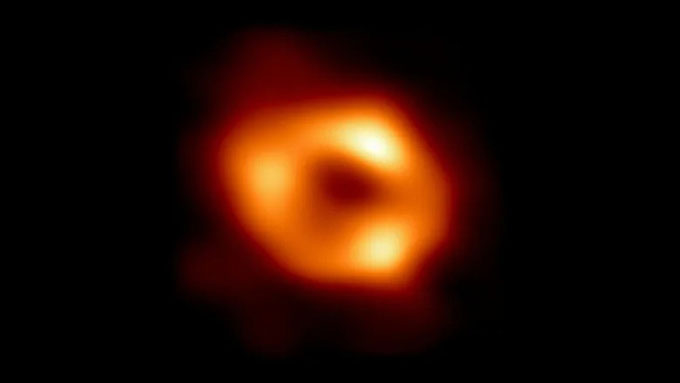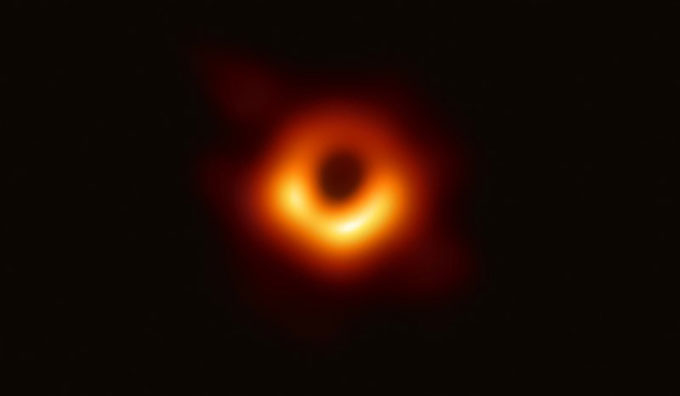Successfully photographed a black hole in the center of the Milky Way
Astronomers on the evening of May 12 released the first image of the supermassive black hole Sagittarius A* at the center of our galaxy.

First image of the black hole Sagittarius A* at the center of the Milky Way.
Using the Event Horizon Telescope (EHT), astronomers have successfully imaged the supermassive black hole Sagittarius A* at the center of the Milky Way, more than 27,000 light-years from Earth. The existence of this mysterious object estimated to be 4 million times more massive than the Sun has long been speculated but it has never been seen until now. The findings, published in a special issue of the Astrophysical Journal Letters on May 12, are the first direct confirmation.
"This unprecedented observation helps us better understand what happens at the center of the Milky Way and provides new insights into how massive black holes interact with their surroundings," the scientist said. Geoffrey Bower at the Sinica Academy of Taiwan, a member of the EHT project, emphasized.
A black hole is a relatively small but dense region of space where gravity is so strong that nothing can escape, not even light. Thus, the new image of Sagittarius A* is not the black hole itself, but the glowing gas surrounding it.
The existence of Sagittarius A* was assumed in 1974 with the discovery of an unusual radio source in the center of the Milky Way. In the 1990s, astronomers mapped the orbits of the brightest stars near its center.
In 2019, this assumption became more and more certain when the team from the EHT project announced for the first time that they had successfully imaged the supermassive black hole at the center of another galaxy, the Messier galaxy 87 from Earth. land 55 million light years. This groundbreaking work was later awarded the Nobel Prize in Physics in 2020.

The EHT imaged the black hole at the center of the galaxy Messier 87 in 2019.
Sagittarius A* shares striking similarities to the black hole at the center of the galaxy Messier 87, known as M87*. Both work as predicted in Einstein's 1915 General Theory of Relativity. "At the edge of these black holes, they look amazingly similar," said Sera Markoff, co-chair of the EHT Science Council and a professor at the University of Amsterdam.
Although Sagittarius A* is only 27,000 light-years from Earth, much closer than M87*, photographing it presents an even greater challenge.
The gas in the vicinity of both black holes travels at about the same speed, close to the speed of light, but while it takes days to weeks to orbit the larger M87*, it takes only a few days. minutes to complete one revolution around Sagittarius A*. The team had to develop new, more sophisticated tools to calculate these moving targets.
"Sagittarius A* is almost 2,000 times smaller than M87* and that means the light orbits it around in 2,000 times less time. That's about 15 minutes. So every 15 minutes, it starts. presents a new face," explains Avery Broderick, Associate Professor at the University of Waterloo and a member of the EHT team.
Scientists are eager to compare two black holes to test theories of how gas behaves around them - a poorly understood phenomenon that may play some role in the formation of stars and galaxies new ha.
Examining black holes - especially at their singularity, where Einstein's equations break - could help physicists deepen their understanding of gravity and develop a more advanced theory. .
- The center of the Milky Way may contain thousands of black holes
- Witness the 'meal' of the super black hole
- Monster black holes are 100,000 times bigger than the Sun.
- The supermassive black hole in the center of the Milky Way is 'hungry' like never before
- The star flies more than 1,000 km / sec after 'hiding' from the black hole
- Discovering the Milky Way's new black hole
- Scientists are about to capture the first image of a cosmic black hole
- Detecting a black hole
- 10 fascinating facts about black holes
- Virtual reality simulation of black holes in the center of the Milky Way
- The supermassive black hole closest to Earth glows intensely
- Discover the mystery of the most exotic black holes in the universe
 Van Allen's belt and evidence that the Apollo 11 mission to the Moon was myth
Van Allen's belt and evidence that the Apollo 11 mission to the Moon was myth The levels of civilization in the universe (Kardashev scale)
The levels of civilization in the universe (Kardashev scale) Today Mars, the sun and the Earth are aligned
Today Mars, the sun and the Earth are aligned The Amazon owner announced a secret plan to build a space base for thousands of people
The Amazon owner announced a secret plan to build a space base for thousands of people